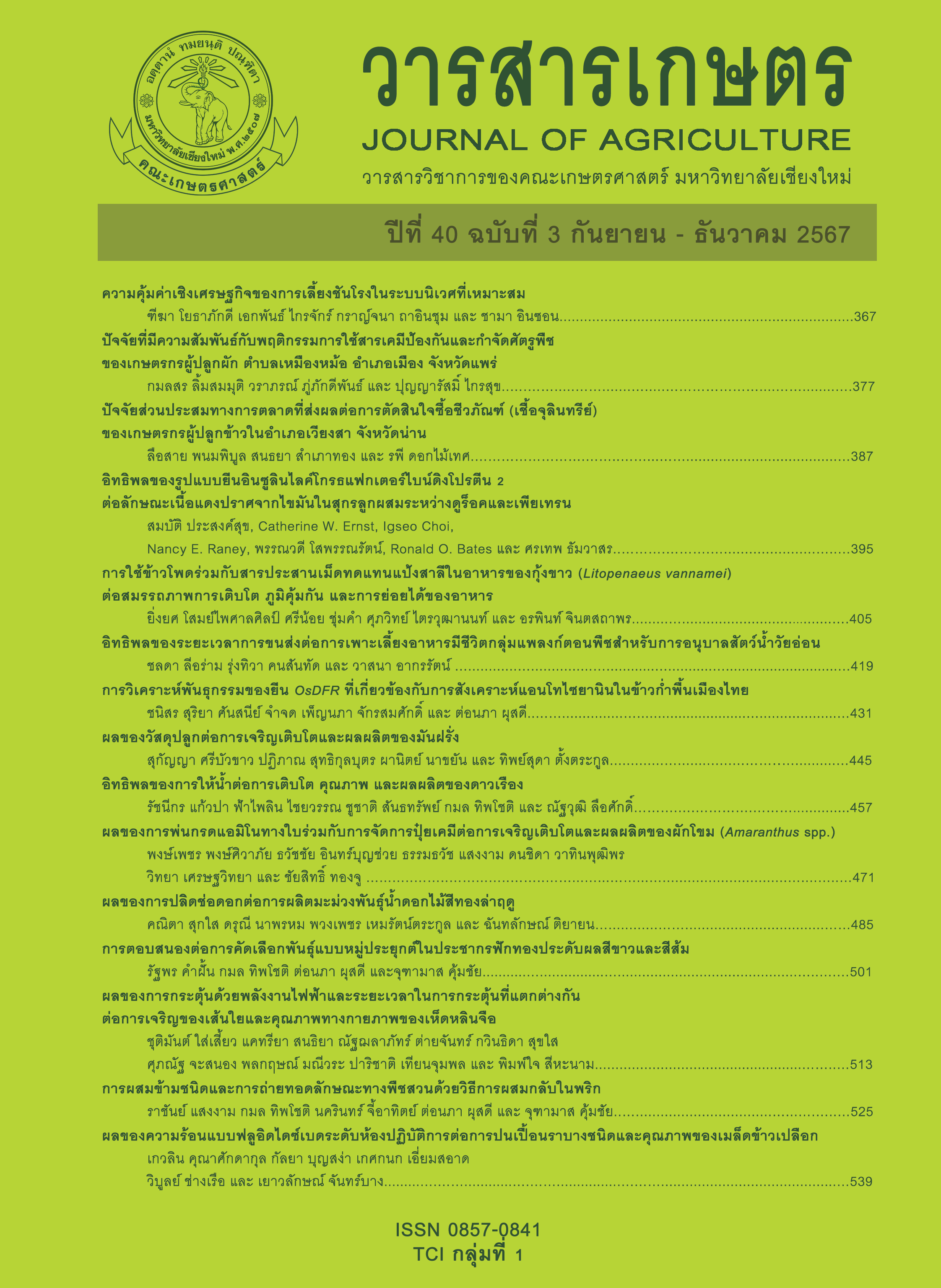การวิเคราะห์พันธุกรรมของยีน <I>OsDFR</I> ที่เกี่ยวข้องกับการสังเคราะห์แอนโทไซยานินในข้าวก่ำพื้นเมืองไทย
Main Article Content
บทคัดย่อ
ข้าวก่ำมีสารแอนโทไซยานินเป็นสารสำคัญ แต่พันธุ์ข้าวก่ำให้ผลผลิตต่ำกว่าพันธุ์ข้าวที่ปรับปรุงสมัยใหม่ ดังนั้นการปรับปรุงพันธุ์ข้าวเพื่อเพิ่มผลผลิตและคุณภาพของเมล็ดข้าว รวมถึงการใช้ประโยชน์จากส่วนต่าง ๆ ของข้าวก่ำนอกจากการบริโภค เป็นทางเลือกหนึ่งที่สามารถเพิ่มรายได้ให้แก่เกษตรกร งานวิจัยนี้มีวัตถุประสงค์เพื่อศึกษาความสัมพันธ์ระหว่างการแสดงออกของยีน OsDFR และปริมาณแอนโทไซยานินในใบข้าวอายุ 45 วันหลังย้ายปลูก และในเมล็ดข้าวกล้อง โดยการจำแนกข้าวก่ำที่ใช้ในงานวิจัยเป็น 2 กลุ่ม คือ กลุ่มที่ 1 ข้าวก่ำที่มีใบและลำต้นสีม่วง ได้แก่ ก่ำดอยสะเก็ด ก่ำพะเยา ก่ำเวียงสา และ K4 กลุ่มที่ 2 ข้าวก่ำที่มีใบและลำต้นสีเขียว ได้แก่ หอมนิล ก่ำหอม มช. ก่ำเจ้า มช. ข้าวเหนียวดำลืมผัว และ BL3 โดยมีข้าวขาวพันธุ์ ปทุมธานี 1 และขาวดอกมะลิ 105 เป็นพันธุ์เปรียบเทียบ วางแผนการทดลองแบบสุ่มสมบูรณ์ จำนวน 3 ซ้ำ ผลการทดลองพบว่า ระดับการแสดงออกของยีน OsDFR มีความแตกต่างกันภายในข้าวก่ำที่มีลักษณะใบและลำต้นสีม่วง โดยก่ำดอยสะเก็ด และก่ำเวียงสามีการแสดงออกของยีน OsDFR มากที่สุด แต่ไม่พบการแสดงออกของยีน OsDFR ในข้าวก่ำกลุ่มที่มีใบและลำต้นสีเขียว พันธุ์ K4 มีปริมาณแอนโทไซยานินที่พบในใบมากที่สุดในขณะที่ K4 และก่ำดอยสะเก็ด มีปริมาณแอนโทไซยานินในเมล็ดข้าวกล้องมากที่สุด สำหรับระดับการแสดงออกของยีน OsDFR ในใบที่อายุ 45 วันหลังย้ายปลูกพบว่ามีความสัมพันธ์เชิงลบระหว่างระดับการแสดงออกของยีน OsDFR กับปริมาณแอนโทไซยานินในใบที่อายุ 45 วันหลังย้ายปลูก และระหว่างผลผลิตเมล็ดต่อปริมาณแอนโทไซยานินในเมล็ดข้าวกล้อง ซึ่งข้อมูลที่ได้จากการศึกษาครั้งนี้พบว่าการวัดระดับการแสดงออกของยีน OsDFR เพียงอย่างเดียวยังไม่มีประสิทธิภาพเพียงพอต่อการนำเครื่องหมายโมเลกุลมาใช้ในการคัดเลือกพันธุ์ข้าวก่ำที่มีแอนโทไซยานินสูง แต่สามารถใช้เป็นข้อมูลพื้นฐานที่สำคัญในการศึกษาเพื่อพัฒนาเครื่องหมายโมเลกุลที่เหมาะสมต่อการคัดเลือกพันธุ์ข้าวก่ำที่มีปริมาณแอนโทไซยานินและผลผลิตสูงต่อไปในอนาคต
Article Details

อนุญาตภายใต้เงื่อนไข Creative Commons Attribution-NonCommercial-NoDerivatives 4.0 International License.
เอกสารอ้างอิง
Danpreedanan, N., S. Yamuangmorn, S. Jamjod, C. Prom-u-thai and T. Pusadee. 2023. Genotypic variation of purple rice in response to shading in yield, anthocyanin content, and gene expression. Plants 12(13): 2582. doi: 10390/plants12132582.
Division of Rice Research and Development. 2016. Khao’ Jow Hawm Phisanulok 1. (Online). Available: https://newwebs2.ricethailand
.go.th/webmain/rkb3/title-index.php-file=content.php&id=022.htm(July 5, 2021). (in Thai)
Fongfon, S., T. Pusadee, C.T. Prom-u-thai and S. Jamjod. 2019. Classification of morphological, agronomic and special grain quality characters among highland purple rice landraces from northern Thailand. Khon Kaen Agriculture Journal 47(6): 1139-1150. (in Thai)
Fongfon, S., T. Pusadee, C. T. Prom-u-thai, B. Rerkasem and S. Jamjod. 2021. Diversity of purple rice (Oryza sativa L.) landraces in northern Thailand. Agronomy 11(10): 2029. doi: 10.3390/agronomy11102029.
Furukawa, T., M. Maekawa, T. Oki, I. Suda, S. Iida, H. Shimada, I. Takamure and K. Kadowaki. 2007. The Rc and Rd genes are involved in proanthocyanidin synthesis in rice pericarp. The Plant Journal 49(1): 91–102.
Huttayanun, T., C. Prom-u-thai, and S. Jamjod. 2016. Selection for photoperiod insensitive advanced lines and high grain anthocyanin of purple glutinous rice. Journal of Agriculture 33(1): 81-90. (in Thai)
Khan, A., S. Jalil, H. Cao, Y. Tsago, M. Sunusi, Z. Chen, C. Shi and X. Jin. 2020. The purple leaf (pl6) mutation regulates leaf color
by altering the anthocyanin and chlorophyll contents in rice. Plants 9(11): 1477. doi: 10.3390/plants9111477.
Lee, J., R. W. Durst and R. D. Wrolstad. 2005. Determination of total monomeric anthocyanin pigment content of fruit juices, beverages, natural colorants and wine by pH differential method: collaborative study. Journal of AOAC international 88(5): 1269-1278. doi: 10.1093/jaoac/88.5.1269.
Phasri, W., K. Panjama, T. Ohyama and P. Hongpakdee. 2016. Quality and quantity of extracted RNA from soybean young leaf by the use of TRIzol® reagent test kit. Khon Kaen Agriculture Journal 44(1): 193-198. (in Thai)
Pusadee, T., A. Wongtamee, B. Rerkasem, K.M. Olsen and S. Jamjod. 2019. Farmers drive genetic diversity of Thai purple rice (Oryza sativa L.) landraces. Economic Botany 73: 76-85.
Pusadee, T., P. Oupkaew, B. Rerkasem, S. Jamjod and B.A. Schaal. 2014. Natural and human-mediated selection in a landrace of Thai rice (Oryza sativa). Annals of Applied Biology 165(2): 280-292.
Rahman, M. M., K. E. Lee and S.G. Kang. 2016. Allelic gene interaction and anthocyanin biosynthesis of purple pericarp trait
for yield improvement in black rice. Journal of Life Science 26(6): 727-736.
Sakulsingharoj, C., P. Inta, R. Sukkasem, S. Pongjaroenkit, S. Chowpongpang and V. Sangtong. 2014. Overexpression of OsB2 gene in transgenic rice up-regulated expression of structural genes in anthocyanin biosynthesis pathway. Thai Journal of Genetic 7(3): 173-182. doi: 10.14456/tjg.2014.24.
Wang, H., W. Fan, H. Li, J. Yang, J. Huang and P. Zhang. 2013. Functional characterization of dihydroflavonol-4-reductase in anthocyanin biosynthesis of purple sweet potato underlies the direct evidence of anthocyanins function against abiotic stresses. PLoS ONE 8(11): 278484. doi: 10.1371/journal.pone.0078484.
Xia, D., H. Zhou, Y. Wang, P. Li, P. Fu, B. Wu and Y. He, 2021. How rice organs are colored: The genetic basis of anthocyanin biosynthesis in rice. The Crop Journal 9(3): 598-608.
Yamuangmorn, S., S. Jumrus, S. Jamjod, K. Sringarm, C. Arjin and C. Prom-u-thai. 2022. Responses of purple rice variety to light intensities and soil zinc application on plant growth, yield and bioactive compounds synthesis. Journal of Cereal Science 106, doi: 10.1016/j.jcs.2022.103495.
Zheng, J., H. Wu, H. Zhu, C. Huang, C. Liu, Y. Chang, Z. Kong, Z. Zhou, G. Wang, Y. Lin and H. Chen. 2019. Determining factors, regulation system, and domestication of anthocyanin biosynthesis in rice leaves. New Phytologist 223(2): 705–721.
Zhu, Q., S. Yu, D. Zeng, H. Liu, H. Wang, Z. Yang, X. Xie, R. Shen, J. Tan, H. Li, X. Zhao, Q. Zhang, Y. Chen, J. Guo, L. Chen and Y.-G. Liu. 2017. Development of ‘‘purple endosperm rice’’ by engineering anthocyanin biosynthesis in the endosperm with a high-efficiency transgene stacking system. Molecular Plant 10(7): 918–929.


